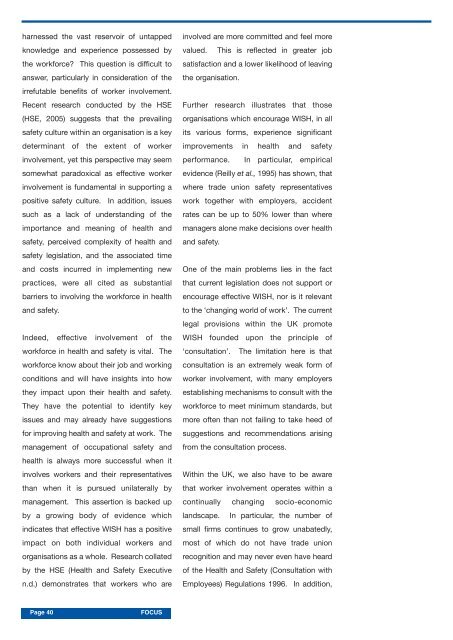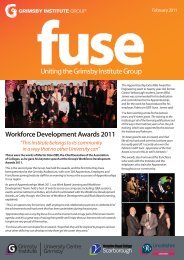Journal of Research & Scholarly Output 2006 - Grimsby Institute of ...
Journal of Research & Scholarly Output 2006 - Grimsby Institute of ...
Journal of Research & Scholarly Output 2006 - Grimsby Institute of ...
You also want an ePaper? Increase the reach of your titles
YUMPU automatically turns print PDFs into web optimized ePapers that Google loves.
harnessed the vast reservoir <strong>of</strong> untapped<br />
knowledge and experience possessed by<br />
the workforce? This question is difficult to<br />
answer, particularly in consideration <strong>of</strong> the<br />
irrefutable benefits <strong>of</strong> worker involvement.<br />
Recent research conducted by the HSE<br />
(HSE, 2005) suggests that the prevailing<br />
safety culture within an organisation is a key<br />
determinant <strong>of</strong> the extent <strong>of</strong> worker<br />
involvement, yet this perspective may seem<br />
somewhat paradoxical as effective worker<br />
involvement is fundamental in supporting a<br />
positive safety culture. In addition, issues<br />
such as a lack <strong>of</strong> understanding <strong>of</strong> the<br />
importance and meaning <strong>of</strong> health and<br />
safety, perceived complexity <strong>of</strong> health and<br />
safety legislation, and the associated time<br />
and costs incurred in implementing new<br />
practices, were all cited as substantial<br />
barriers to involving the workforce in health<br />
and safety.<br />
Indeed, effective involvement <strong>of</strong> the<br />
workforce in health and safety is vital. The<br />
workforce know about their job and working<br />
conditions and will have insights into how<br />
they impact upon their health and safety.<br />
They have the potential to identify key<br />
issues and may already have suggestions<br />
for improving health and safety at work. The<br />
management <strong>of</strong> occupational safety and<br />
health is always more successful when it<br />
involves workers and their representatives<br />
than when it is pursued unilaterally by<br />
management. This assertion is backed up<br />
by a growing body <strong>of</strong> evidence which<br />
indicates that effective WISH has a positive<br />
impact on both individual workers and<br />
organisations as a whole. <strong>Research</strong> collated<br />
by the HSE (Health and Safety Executive<br />
n.d.) demonstrates that workers who are<br />
involved are more committed and feel more<br />
valued. This is reflected in greater job<br />
satisfaction and a lower likelihood <strong>of</strong> leaving<br />
the organisation.<br />
Further research illustrates that those<br />
organisations which encourage WISH, in all<br />
its various forms, experience significant<br />
improvements in health and safety<br />
performance. In particular, empirical<br />
evidence (Reilly et al., 1995) has shown, that<br />
where trade union safety representatives<br />
work together with employers, accident<br />
rates can be up to 50% lower than where<br />
managers alone make decisions over health<br />
and safety.<br />
One <strong>of</strong> the main problems lies in the fact<br />
that current legislation does not support or<br />
encourage effective WISH, nor is it relevant<br />
to the ‘changing world <strong>of</strong> work’. The current<br />
legal provisions within the UK promote<br />
WISH founded upon the principle <strong>of</strong><br />
‘consultation’. The limitation here is that<br />
consultation is an extremely weak form <strong>of</strong><br />
worker involvement, with many employers<br />
establishing mechanisms to consult with the<br />
workforce to meet minimum standards, but<br />
more <strong>of</strong>ten than not failing to take heed <strong>of</strong><br />
suggestions and recommendations arising<br />
from the consultation process.<br />
Within the UK, we also have to be aware<br />
that worker involvement operates within a<br />
continually changing socio-economic<br />
landscape. In particular, the number <strong>of</strong><br />
small firms continues to grow unabatedly,<br />
most <strong>of</strong> which do not have trade union<br />
recognition and may never even have heard<br />
<strong>of</strong> the Health and Safety (Consultation with<br />
Employees) Regulations 1996. In addition,<br />
Page 40<br />
FOCUS

















